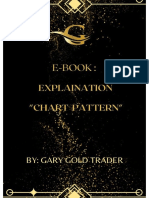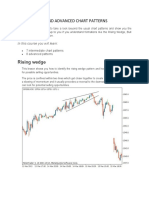100% (1) 100% found this document useful (1 vote) 6K views 70 pages Chart Pattern Master
The document is a comprehensive guide on Forex trading, focusing on technical analysis and various chart patterns such as triangles, head and shoulders, and flags. It provides detailed illustrations, trading strategies, and real examples for each pattern, emphasizing the importance of money management in trading. The guide aims to equip traders with the knowledge to effectively analyze and utilize chart patterns for profitable trading decisions.
Copyright
© © All Rights Reserved
We take content rights seriously. If you suspect this is your content,
claim it here .
Available Formats
Download as PDF or read online on Scribd
Go to previous items Go to next items
Save Chart Pattern Master For Later A\ THE FOREX TRADING GUIDE
TECHNICAL ANALYSIS SERIES
IN THIS BOOK
SYMMERTRICAL TRIANGLE ASCENDING TRIANGLE
DESCENDING TRIANGLE HEAD AND SHOULDERS + INVERSE
CUP AND HANDLE + INVERSE] [FALLING WEDGE / RISING WEDGE
RECTANGLE FLAG a SL
DOUBLE TOP / DOUBLE BOTTOM! [TRIPLE TOP / TRIPLE BOTTOM�ine THE FOREX TRADING GUIDE
© TECHNICAL ANALYSIS — CHART PATTERNS
Copyright © 2016 TradingSpine
All rights reserved by TradingSpine. No parts of this work may be reproduced in any form or by any
means - graphic, electronic, or mechanical, including photocopying, recording, taping, or
information storage and retrieval systems - without the written permission of the author.
The information provided within this eBook is for general informational purposes only. While we
try to keep the information up-to-date and correct, there are no representations or warranties,
express or implied, about the completeness, accuracy, reliability, suitability or availability with
respect to the information, products, services, or related graphics contained in this eBook for any
Purpose. Any use of this information is at your own risk.�ine THE FOREX TRADING GUIDE
© TECHNICAL ANALYSIS — CHART PATTERNS
TABLE OF CONTENTS
1. WHAT THIS BOOK PROVIDES TO YOU.
2. SYMMETRICAL TRIANGLE.
2.1 bullish symmetrical triangle illustration and structure
2.2 notes...
2.3 trading the patter
2.4 pattern's reward:risk.
2.5 bullish symmetrical triangle real example.
2.6 bearish symmetrical triangle illustration and structure.
2.7 bearish symmetrical triangle real example.
3, ASCENDING TRIANGLE.
3.1 illustration and structure (bullish]
3.2 notes...
3.3 trading the pattern...
3.4 pattern's reward:ris
3.5 real example (bull
4, DESCENDING TRIANGLE.
4.1 illustration and structure (bearish).
4.2 notes.
4.3 trading the pattern.
4.4 pattern's reward:risk
45 real example (bearish)...
5. HEAD AND SHOULDERS...
5.1 illustration and structure...
5.2 notes...
5.3 trading the pattern...
5.4 pattern's reward:risk.
5.5 head and shoulders real example.
5.6 inverse head and shoulders illustration and structure.
5.7 inverse head and shoulders real example.
ee | aD�ine THE FOREX TRADING GUIDE
© TECHNICAL ANALYSIS — CHART PATTERNS
6. CUP AND HANDLE. .ssssesen steineentninsnsne
6.1 cup and handle illustration and structure...»
6.2 notes.
6.3 trading the patteri
6.4 pattern's reward:risk....
6.5 cup and handle real example... .
6.6 inverse cup and handle illustration and structure...
6.7 inverse cup and handle real example
7. WEDGE
7.1 falling wedge illustration and structUre....neesenmne wsiniinicaecnencncciais DD
7.2 notes
7.3 trading the pattern.
7.4 pattern's reward:risk...
7.5 falling wedge real example...
7.6 rising wedge illustration and structure,..smmenninnnensnnsenn
7.7 rising wedge real example....
8. RECTANGLE...
8.1 bullish rectangle illustration and structure.
8.2 notes...
8.3 trading the pattern
8.4 pattern's reward:rist
8.5 bullish rectangle real exampl
8.6 bearish rectangle illustration and structure.
8.7 bearish rectangle real example....o:es-
9. FLAG.
9.1 bullish flag illustration and structure. 37
9.2 notes.
9.3 trading the patter
9.4 pattern's reward:risk.
95 bullish flag real example.
9.6 bearish flag illustration and structure.
9,7 bearish flag real example...
ee | aD�ine THE FOREX TRADING GUIDE
© TECHNICAL ANALYSIS — CHART PATTERNS
10. PENNANT..
10.1 bullish pennant illustration and structure,
10.2 notes.
10.3 trading the pattern..
10.4 pattern's reward:risk......
10.5 bullish pennant real example......
10.6 bearish pennant illustration and structure.
10.7 bearish pennant real example.
11. DOUBLE TOP / DOUBLE BOTTOM.
11.1 double top illustration and structure (bearish) : eT
11.2 notes...
11.3 trading the pattern
11.4 pattern's reward:risk..
1.5 double top real example (bearish)...
11.6 double bottom illustration and structure (bearish)...
11.7 double bottom real example (bearish).
12, TRIPLE TOP / TRIPLE BOTTOM...
12.1 triple top illustration and structure (bullish)..
12.2 notes.
12.3 trading the pattern,
12.4 pattern's reward:risk..
12.5 triple top real example (bullish).
12.6 triple bottom illustration and structure (bullish
12.7 triple bottom real example (bullish) .1sssnssnsennneee
13, DIFFERENTIATING CHART PATTERNS.
13.1 table of patterns’ (direction, type, occurrence, term). 57
13.2 table of patterns' (target, failure) measurements.
13.3 differentiating patterns.
14, USING THIS BOOK TO YOUR ADVANTAG!
14.1 how to proceed from here.
14.2 why and when do we use (7%, 14%, 21%) for stop loss safety..
14.3 a few points to consider.
ee | ap�TradingSpine THE FOREX TRADING GUIDE
© TECHNICAL ANALYSIS — CHART PATTERNS
Unlike most sources of information available for Forex chart patterns, this book won't stop at the
technical analysis characteristics of the different patterns. The chart patterns are a part of a
whole, and our goal here is to show and explain the whole picture so you can trade profitably
using the knowledge gathered from this book,
To reach that goal we will go through three main topics throughout the book
+ The first topics the technical aspect of the chart patterns covered in the book, this
includes detailed illustration for the patterns' price action structure as well as target (take
profit) and failure (stop loss) measurements, before finalizing each chart pattern with a
full real trading setup as a usage example for the pattern in real trading.
+ The second topic will be tabular data for all the chart patterns, which can be helpful when
choosing patterns that suits your trading style the most, followed by an explanation of
how to differentiate similar looking patterns using price action highs and lows.
+ The third and most important topic is how to use that technical knowledge gathered for
the different chart patterns in a real Forex money management plan for a trading cycle, to
achieve that we will use our own strategy to show the the whole thought process before
starting a trading cycle.
Before we dive right into the interesting content, remember that Forex trading -and trading in
general- is not only about the analysis of charts or financial news, it heavily relies on both money
management and trading management for consistency reasons, therefore trading a chart pattern
must be a part of bigger plan.�THE FOREX TRADING GUIDE
TECHNICAL ANALYSIS — CHART PATTERNS
MMETRICAL TRIANGLE
2.1 BULLISH SYMMETRICAL TRIANGLE ILLUSTRATION AND STRUCTURE
COST ET
Direction:
Continuation
ae ee
Type:
Bullish
Occurrence:
High
‘Common term:
Medium - Long
Ree ued)
PRICE ACTION:
+ In.an uptrend, price action finds first resistance (1), which will be the highest high in the
pattern, where it reverses direction and goes downwards till finding first support (2), which
will be the lowest low in the pattern.
* Price action reverse direction from support (2) going upwards, tll finding the second
resistance (3), which must to be lower than the first resistance (1).
* Price action reverse direction from resistance (3) going downwards, till finding the second
support (4), which must to be higher than the first support (2).
* The pattern is completed when price action reverse direction from (4) and goes upwards till
it breaks the triangle's upper border at point (5)�ine THE FOREX TRADING GUIDE
© TECHNICAL ANALYSIS — CHART PATTERNS
2.2 NOTES
* Before the breakout, 4 touches to the triangle's borders are the minimum for a valid
pattern, more touches are acceptable.
* Although named symmetrical, the upper and lower borders don't have to be actually
symmetrical, as long as lower highs (1 - 3 - ..) and higher lows (2-4 -...) are being formed,
the pattern is considered valid.
+ The breakout of the pattern is expected at around (half / two third) the triangle's
formation, measured from first touch (1) to the intersection point of upper and lower
borders.
* The more common direction for the pattern is continuation, but that doesn’t rule out the
existence of reversal symmetrical triangles.
* Volume usually decreases as the pattern is being formed, and increases when breaking or
retesting the triangle's border (5).
+ This pattern is commonly found on medium and long-term time-frames
2.3 TRADING THE PATTERN
* Trade entry: after breaking the triangle's border at point (5), either with an entry after
confirming the breakout, or after a -possible- retest to the breakout rate.
* Take profit: identified by measuring the vertical distance from the first touch (1) to the
second touch (2), that measurement is then applied from the breakout point (5).
+ Stop loss: can either be the breakout rate (5), or the last touch to the triangle's border (4)
before the breakout.
2.4 PATTERN'S REWARD:RISK
+ When using the last touch before the breakout as stop loss, the pattern's R:R improves
when that touch is near the end of the triangle.
* When using the breakout rate as stop loss, R:R will depend on the (entry rate - break rate)
distance, compared to the target measurement (1 - 2),
* Always remember that both stop loss levels explained above are absolute, the actual stop
loss rate for your trade setup should be a bit beyond those levels to give the trade setup
some room to breathe, and of-course calculations for position size and R:R should be done
with respect to those rates.
Feel free to leave us a comment and discuss this pattern directly on our website at:
https://www.tradingspine.com/articles/chart-patterns/symmetrical-triangle.php
ee | aD



























































